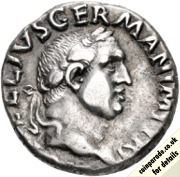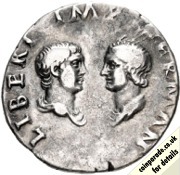
 The 69AD Denarius - Vitellius / with his children
The 69AD Denarius - Vitellius / with his children Silver Denarius of Emperor Vitellius, struck in 69AD at the Rome Mint. Diameter 17mm and weighs 3.06g. RIC I 79.
The Obverse shows the laureate head of Emperor Vitellius facing right. Legend around is "[A VIT]ELLIVS GERMAN IMP TR P".
The edge is plain.
 The Reverse shows the children of Vitellius. His son, Vitellius Germanicus on the left facing his daughter Vitellia on the right. Legend around is "LIBERI IMP GERMAN".
The Reverse shows the children of Vitellius. His son, Vitellius Germanicus on the left facing his daughter Vitellia on the right. Legend around is "LIBERI IMP GERMAN".Image credit: CNG Coins
Mintage: Not known
Minted at Roman Mint
More information (monarch, year, mint, country, category) can be found below coin listings.
Below are some coins currently being offered on eBay. As an eBay Partner, We may be compensated if you make a purchase.
List items on:
List items on:
Remember 69 ?
Britain was occupied by the Romans, but in the Roman Empire it was The Year of the Four Emperors: Galba, Otho, Vitellius, and Vespasian.
Vitellius (Emperor 69AD-69AD)
Born Aulus Vitellius on 24 September 15AD, Vitellius became Emperor on 17 April 69AD. 69AD was the Year of the Four Emperors and Vitellius was the third, and he lasted 8 months. As conflict reached a peak, Vitellius decided to abdicate but was killed by an angry mob. He died on 20 December 69AD aged 54.Although Vitellius ruled for only a short period, he minted coins at the Spanish mint of Tarraco (now Tarragona) from January 69AD, and later from the Lugdunum Mint (now Lyon, France). By the summer the Mint of Rome was used. Every coin of Vitellius features the title "Germanicus", referring to the legions of the Rhine that supported his bid for power, shortened to "Germ" on legends.
The coins minted before his official proclamation on 19 April 69AD did not use "Augustus". After his election on 18 July 69AD coins carried the title "Pontifex Maximus". The final coins of Vitellius were the aurei and denarii, with the reverse showing (maybe optimistically) the goddess Victory building a trophy.
Title: AVLVS VITELLIVS GERMANICVS AVGVSTVS
Category: Roman
The Roman Empire was one of the largest Empires in history, covering most of Europe, Britain, parts of Asia, the Middle East and North Africa. It was in existence from 27BC to 476AD, more than 500 years. And all these places used Roman coins throughout the era.Originally coins were minted only in Rome, but by the third Century there were mints in other countries too. These mints sometimes produced more than 2 million coins per month to meet demand. Coins typically depicted the Emperor on one side and some other image or letters on the other. During the Empire, more than 10,000 different types of coins were created using copper, silver and gold.
Roman coins are usually classified as:
- Roman Republican Coins (about 300BC - 27BC)
- Roman Imperial Coins (27BC - 96AD)
- Roman Imperial Coins (96AD - 235AD)
- Roman Imperial Coins (235AD - 476AD)
- Roman Provincial Coins
The Denarius was the standard Roman silver coin and there were a range of others. As a guide, in the early republic (after 211BC) there was the Sestertius (=4 denarii), Dupondius (=5), As (=10, a tenner), Semis (=20), Quincunx (=24), Triens (=30), Quadrans (=40), Uncia (=120) and Solidus (=1000, it was gold). Values fluctuated later due to debasement and inflation.
The exchange values were as follows:
1 gold aureus = 25 silver denarii
1 silver denarius = 16 copper asses
1 brass sestertius = 4 copper asses
1 brass dupondius = 2 copper assses
1 copper as = 2 copper semisses (or 4 copper quadrantes)
The standard gold coin was the Aureus and was equal to 25 denarii or 100 sestertii. It's not far off the weight of a modern gold sovereign. The Aureus was introduced by Julius Caesar around 49BC and was the principal gold coin until about the 4th century when it was replaced by the gold Solidus.
The great part of this is that you can put together a really nice Roman coin collection with very little money, as many coins (although not all) are common and inexpensive. The coins are the best part of 2000 years old and are exciting to collect.
For more information see our articles:
Which Mint: Roman Mint
The origins of the Rome mint are from the manufacture of a silver coin near to the Temple of Juno Moneta back in 269BC. Juno was the personification of money.Due to the size of the Roman Empire, Rome could not produce all the coins needed and Roman mints were set up in 27 locations, and there were more than 600 provincial mints scattered about the Empire. During overseas campaigns, Generals such as Caesar and Marc Anthony would mint their own coins to pay their armies.
Mint marks were used on the coins to differentiate the mint of manufacture.
Country of Origin: Roman Empire
The Roman Empire ran from 27BC to 476AD and was the post-Republican period of ancient Rome. It covered a large territory of Europe, Northern Africa, and Western Asia. It was ruled by an Emperor.







